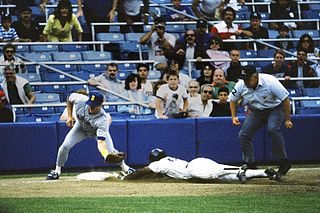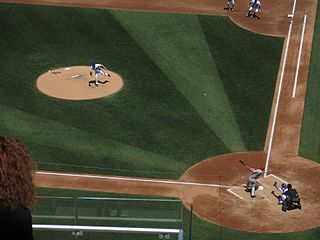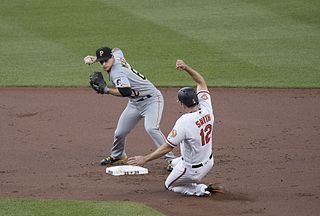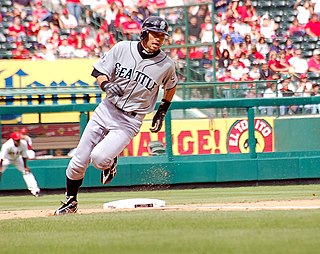Related Research Articles
Baseball statistics play an important role in evaluating the progress of a player or team.

In baseball, an at bat (AB) or time at bat is a batter's turn batting against a pitcher. An at bat is different from a plate appearance. A batter is credited with a plate appearance regardless of what happens during their turn at bat, but a batter is charged with an at bat only if that plate appearance does not have one of the results enumerated below. While at bats are used to calculate certain statistics, including batting average and slugging percentage, a player can qualify for the season-ending rankings in these categories only if they accumulate 502 plate appearances during the season.

In baseball, a stolen base occurs when a runner advances to a base unaided by other actions and the official scorer rules that the advance should be credited to the action of the runner. The umpires determine whether the runner is safe or out at the next base, but the official scorer rules on the question of credit or blame for the advance under Rule 10 of the MLB's Official Rules.

In baseball, a player is credited with a plate appearance each time he completes a turn batting. Under Rule 5.04(c) of the Official Baseball Rules, a player completes a turn batting when he is put out or becomes a runner. This happens when he strikes out or is declared out before reaching first base; or when he reaches first base safely or is awarded first base ; or when he hits a fair ball which causes a preceding runner to be put out for the third out before he himself is put out or reaches first base safely. A very similar baseball statistic, at bats, counts a subset of plate appearances that end under certain circumstances.

Baseball is a bat-and-ball sport played between two teams of nine players each, taking turns batting and fielding. The game occurs over the course of several plays, with each play generally beginning when a player on the fielding team, called the pitcher, throws a ball that a player on the batting team, called the batter, tries to hit with a bat. The objective of the offensive team is to hit the ball into the field of play, away from the other team's players, allowing its players to run the bases, having them advance counter-clockwise around four bases to score what are called "runs". The objective of the defensive team is to prevent batters from becoming runners, and to prevent runners' advance around the bases. A run is scored when a runner legally advances around the bases in order and touches home plate.

In baseball, a home run is scored when the ball is hit in such a way that the batter is able to circle the bases and reach home plate safely in one play without any errors being committed by the defensive team. A home run is usually achieved by hitting the ball over the outfield fence between the foul poles without the ball touching the field.
In baseball, a sacrifice bunt is a batter's act of deliberately bunting the ball, before there are two outs, in a manner that allows a baserunner to advance to another base. The batter is almost always put out, and hence sacrificed, but sometimes reaches base on an error or fielder's choice. In that situation, if runners still advance bases, it is still scored a sacrifice bunt instead of the error or the fielder's choice. Sometimes the batter may safely reach base by simply outrunning the throw to first; this is not scored as a sacrifice bunt but rather a single.

In baseball and softball, a double play is the act of making two outs during the same continuous play. Double plays can occur any time there is at least one baserunner and fewer than two outs.
In baseball, a triple play is the act of making three outs during the same play. There have only been 735 triple plays in Major League Baseball (MLB) since 1876, an average of just over five per season.

In baseball and softball statistics, an error is an act, in the judgment of the official scorer, of a fielder misplaying a ball in a manner that allows a batter or baserunner to advance one or more bases or allows a plate appearance to continue after the batter should have been put out. The term error is sometimes used to refer to the play during which an error was committed.

In the game of baseball, the official scorer is a person appointed by the league to record the events on the field, and to send the official scoring record of the game back to the league offices. In addition to recording the events on the field such as the outcome of each plate appearance and the circumstances of any baserunner's advance around the bases, the official scorer is also charged with making judgment calls that do not affect the progress or outcome of the game. Judgment calls are primarily made about errors, unearned runs, fielder's choice, the value of hits in certain situations, and wild pitches, all of which are included in the record compiled. This record is used to compile statistics for each player and team. A box score is a summary of the official scorer's game record.

Extra innings is the extension of a baseball or softball game in order to break a tie.

In baseball, an inside-the-park home run is a rare play in which a batter rounds all four bases for a home run without the baseball leaving the field of play. It is also known as an "inside-the-parker", "in-the-park home run", or "in-the-park homer".

In baseball, the batting order or batting lineup is the sequence in which the members of the offense take their turns in batting against the pitcher. The batting order is the main component of a team's offensive strategy. In Major League Baseball, the batting order is set by the manager, who before the game begins must present the home plate umpire with two copies of his team's lineup card, a card on which a team's starting batting order is recorded. The home plate umpire keeps one copy of the lineup card of each team, and gives the second copy to the opposing manager. Once the home plate umpire gives the lineup cards to the opposing managers, the batting lineup is final and a manager can make changes only under the Official Baseball Rules governing substitutions. If a team bats out of order, it is a violation of baseball's rules and subject to penalty.

Throughout the history of baseball, the rules have frequently changed as the game continues to evolve. A few common rules most professional leagues have in common is that four balls is a base on balls, three strikes is a strikeout, and three outs end a half-inning.
In baseball, interference occurs in situations in which a person illegally changes the course of play from what is expected. Interference might be committed by players on the offense, players not currently in the game, catchers, umpires, or spectators. Each type of interference is covered differently by the rules.

Tyrone Alexander Cline is an American former professional baseball player, primarily a reserve outfielder and pinch hitter, who played in Major League Baseball (MLB) for the Cleveland Indians (1960–62), Milwaukee / Atlanta Braves, Chicago Cubs (1966), San Francisco Giants (1967–68), Montreal Expos (1969–70) and Cincinnati Reds (1970–71). He threw and batted left-handed and was listed as 6 feet (1.8 m) tall and 170 pounds (77 kg).
This is an alphabetical list of selected unofficial and specialized terms, phrases, and other jargon used in baseball, along with their definitions, including illustrative examples for many entries.
The wheel play is a defensive strategy in baseball designed to defend against a sacrifice bunt. The play's name derives from the wheel-like rotation of the infielders.

The 2020 Oakland Athletics season was the 120th season for the Oakland Athletics franchise, all as members of the American League, and their 53rd season in Oakland. The season saw the Athletics win the American League West for the first time since 2013.
References
- 1 2 Official Rules | MLB.com
- ↑ "Torrealba's slam, five sac flies power Rockies past Bucs". ESPN.com. Associated Press. June 7, 2006.
- ↑ Stone, Larry (April 16, 2008). "Seattle Mariners ride flurry of sacrifice flies to 11-6 victory over Kansas City Royals". Seattle Times..
- ↑ Sacrifice Flies Records
- ↑ Single Season Records, baseball-reference.com.
- ↑ "Career Leaders & Records for Sacrifice Flies". Baseball Reference. Retrieved June 22, 2018.
- ↑ "World Series Final Outs". Baseball Almanac. Retrieved 13 June 2017.
- ↑ "1912 World Series". Baseball Almanac. Retrieved 13 June 2017.
- ↑ Chadwick, Henry (1893). The Reliable Book of Outdoor Games. F. M. Lupton. p. 62. ISBN 9785872410195.
- ↑ Holtzman, Jerome (2005). Jerome Holtzman on Baseball - A History of Baseball Scribes. Sports Publishing. p. 198. ISBN 9781582619767.
- ↑ Creamer, Robert W. (2000). Baseball and Other Matters in 1941. University of Nebraska Press. p. 272. ISBN 9780803264069.